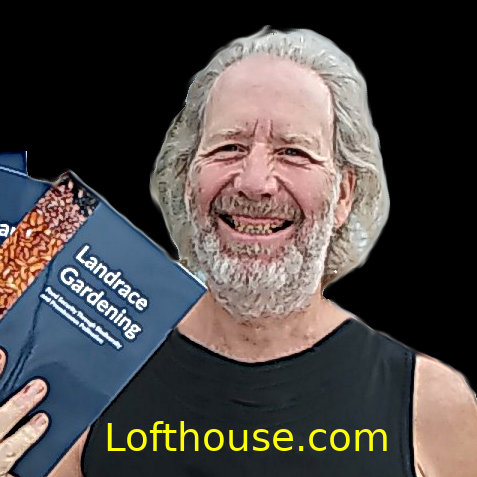

[ Articles ]
[ Seed List ]
[ Bio ]
[ Buy my book]
  |
[ Media ] [ Articles ] [ Seed List ] [ Bio ] [ Buy my book] |
I am breeding an open pollinated landrace of homozygous sugary enhanced (se) multi-colored sweet corn on my farm in Paradise Utah. I call it "Paradise Sweet Corn" in honor of the town where it was developed. Paradise sweet corn contributed genes to "Lofthouse Sweet Corn" an su/se hybrid which is named in honor of my father who has gardened for decades in Paradise.
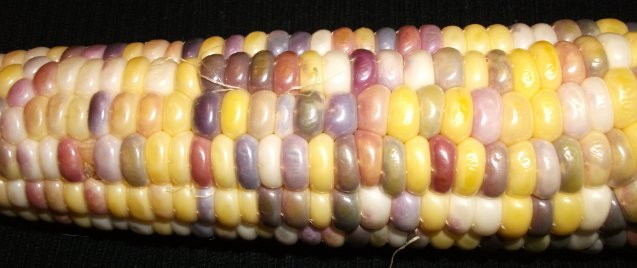
- Colored corn is fun!
- I believe Multi-colored corn is more nutritious.
- My customers prefer the taste and keeping qualities of sugary enhanced corn.
- The sugary enhanced (se) gene is easier for farmers to work with than the shrunken (sh2) gene.
- Buying new hybrid seeds every year costs too much.
- By planting open pollinated seeds I spread my harvest over a longer time so that every ear in the patch isn't ready on the same day.
- By developing my own open pollinated landrace of sugary enhanced sweet corn I am working to insure that I have a reliable source of affordable seed that is especially adapted to growing on my farm.
- By breeding a genetically diverse adaptivar population I am building crop insurance into my seeds so that if a new pest appears, or the climate changes there is a good chance that some individuals in the population will thrive under the new conditions.
- Producing my own seed protects my farm and my customers from social dangers such as politics, crop failure, monopolies, high seed prices, market volatility, drought in Iowa, fuel shortages, transportation strikes, economic meltdown, genetically modified organisms, and end-of-the-world scenarios.
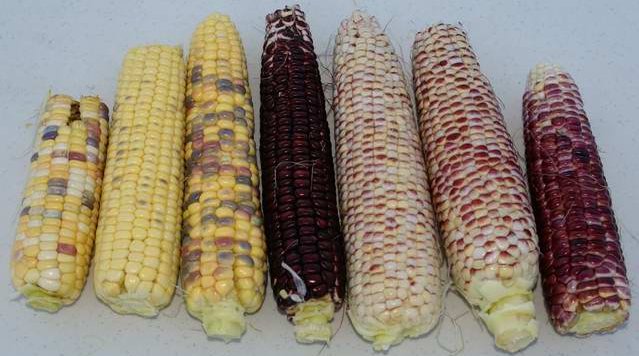
I planted alternating blocks of non-proprietary hybrid sweet corns (homozygous for the se gene, and mixed to provide a wide range of maturity) with open pollinated landraces of sweet corns and Indian corns. The landraces were detassled so that all the pollen was contributed by the homozygous sweet corns. Most of the sugary enhanced sweet corn (fathers) were sold at market, except that some ears were saved for use as a de-hybridized population of sugary enhanced sweet corn.The breeding program is a cooperative venture with other great plant breeders and is using their partially enhanced segregating sweet corn seed as a starting point.
The sugar content of cobs from each plant is measured when they are at the fresh eating stage. I start by cutting off the end of a cob and tasting it. This separates ears into low, medium, and high sugar and a few that are just nasty. The taste test would be sufficient to develope a really sugary and nice variety of open pollinated sweet corn.
- J. Spero's Sparkler (Anasazi), 51-A (Black Aztec), and Red and Gold (Shawnee Fire)
- A. Bishop's Astronomy Domine by way of Johno
- Long Island Seed Project's Ashworth and early Festival
The amount of sugar can also be measured (approximately) by squeezing some juice from one kernel directly onto the sample window of an inexpensive refractometer calibrated in percent sugar. Some cobs contain around 10% or less sugar and some contain up to 30% sugar.
Sugary enhanced kernles may be selected before planting by tossing them into a cup of water and observing how fast they absorb water. Sugary enhanced kernels plump up quickly (12-48 hours depending on variety), while normal sweet corn kernels stay wrinkled for a long time. I use this method for selecting seeds for planting the day before they go into the ground. Damaged kernels also plump up quickly regardless of genetics and can be eliminated early on. An alternate method of bulk selection is to drop the seeds into a sugar water solution (3 parts sugar to 2 parts water) just before planting to separate them based on density. (Most sugary enhanced seeds sink while normal sweet corn and flour corn usually float.)
Seeds from non se+ cobs are saved in bulk for backcrossing or segregating the following year.
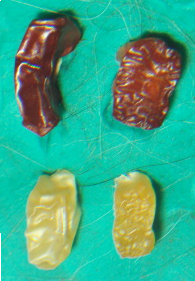
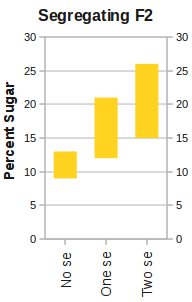
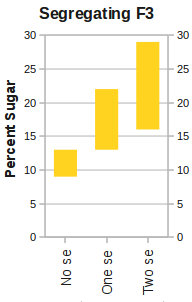
Expected sugar per cob in segregating F2 and F3 hybrids, based on genotype of mother.
Special thanks goes out to early plant breeders who have contributed genes to this project including: Dave Christensen's Painted Mountain, and A. Kapuler's Rainbow Inca and Painted Hills and thanks also to every indiginous farmer and prudent gardener that ever saved corn seeds for planting next year. Sweet corn varieties that have contributed genes to my landrace include old-time favorite heirlooms, and the best producing modern hybrids, such as: Astronomy Domine, Blue Jade, Millersburg Red, Millersberg Red #2, Millersburg small, Red 101, Martian Double Red, Triple Play, Black Mexican, Black Puckers, Country Gentleman, White 101, Hopi-Pink Sweet, Hookers, Howling Mob, Double Standard, Double Red, Washington County Orange, Silver King, Golden Bantam, Ashworth, Pastel Colors, Early Festival Multicolor, Rainbow Inca, Painted Hills, Luther Hill, Ruby Queen-se, Precocious-se, Bodacious-se, Incredible-se, Ambrosia-se, Tuxedo-se, Cocopah, Nueta, Aunt Mary's, Anasazi sweet, Colorado Sweet Indian, and many unnamed varieties that are maintained by small-scale farmers and home gardeners. Seeds from many Indian corns are being incorporated into the sugary enhanced landrace as they are obtained and the su1 and se genes are back-crossed into them. Varieties that were introduced into the program in 2010 include: Joseph's white dent, Joseph's red dent, Joseph's purple, Anasazi flour, popcorn, Joseph's flint and flour landrace, Nevada black Aztec-su and Black Aztec-su, Peruvian purple, Earthtones dent, Taos blue, Hopi blue, Hopi pink, Missouri sweet indian-su, Missouri flour, cherry flavored flour corn, Triple play-su, Painted mountain, Martin Jewels, and Farm-stand indian-su. During the 2011 growing season the genetic base was expanded to start including corns from the Mexican highlands race which is currently underrepresented. The new varieties being crossed and trialed included: Oaxacan Black pyramid, Posole, Maricopa sweet, Anazasi Flour, Anasazi sweet, Oaxacan green, and Hopi greasy head. Additionally in the 2011 growing season the descendents of a couple hundred varieties of sweet corn were incorporated into the breeding program.Sharing
Due to the currently strange economic conditions, I am not selling seeds. Some varieties of my seeds can be obtained from:-----
After my book came out, requests poured in for varieties mentioned in the book. It takes me at least an hour per request to handle the correspondence, find the seed, package it, and get it to the post office. If you ask me directly for seed, or information about varieties, please consider making a donation large enough to cover an hour or two of a celebrity's time.
My Other Landraces
Landrace garden crops
Warm Regards,
Joseph

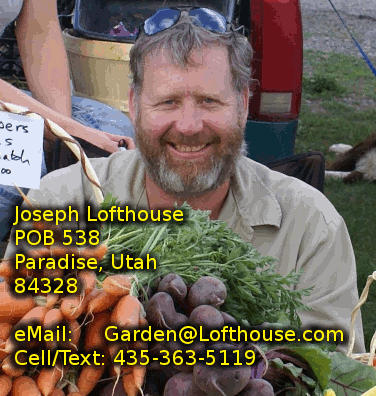
Join me at the Heritage Grain Alliance